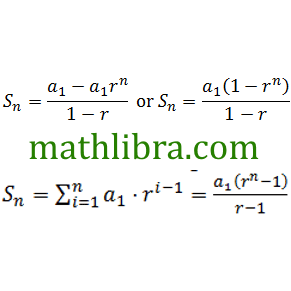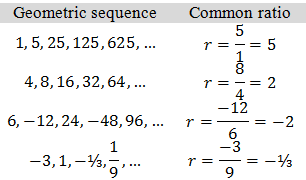General Equation for the nth-term of a Geometric Sequence
From the above example we know a1=2 and r=2, and we have seen from the table that the nth-term is given by an=2×2(n-1). Thus, in general,
where a1 is the first term and r is called the common ratio.
So, if we want to know how many people are newly-infected after 10 days, we need to work out a10.
a10=2⋅r(10-1)
2×29=2×512=1024.
That is, after 10 days, there are 1024 newly-infected people.
Or, how many days would pass before 16, 384 people become newly infected with the flu virus?
16, 384=2⋅2(n-1)
16, 384÷2=2(n-1)
8 192=2(n-1)
213=2(n-1)
13=n-1
n=14.
That is, 14 days pass before 16, 384 people are newly-infected.
📌 Example 1. Determine the number of terms in the sequence: 2, 4, 8, …, 1024.
✍ Solution:
a⋅r(n-1)=1024
2⋅2(n-1)=210→2n=210
n=10
📌 Ex2. Find n in the geometric sequence 4, -2, 1, …. if an=1/16
✍ Solution:
Since 4, -2, 1, …
Here, a=4, r=-2÷4=-½, an=1/16
1/16=4⋅(-½)(n-1)
1/64=(-½)(n-1)
(-½)6=(-½)(n-1)
6=n-1→n=7.
We can also check whether a given number belongs to a given geometric sequence.
📌 Question 1. Does the number 48 belong to the geometric sequence
✍ Solution:
Here a=3072 and r=½, so an=3072×½(n-1).
We set 3072×½(n-1)=48. This gives ½(n-1)=1/64, that is, 2(n-1)=64=26, and so n=7.
Hence, 48 is the 7th term of the sequence.
📌 Q2. Does the number 6072 belong to the geometric sequence
✍ Solution:
Here a=3 and r=-2, so an=3×(-2)(n-1).
We set 3×(-2)(n-1)=6072. This gives (-2)(n-1)=2024.
But 2024 is not a power of 2, and so 6072 does not belong to the sequence.
If given a sequence then check whether it is either arithmetic, geometric or quadratic.
📌 Q3. Given the sequence 1, ⅔, 9/4, ….
a) Determine the next two terms
b) Which term of the sequence is equal to 32/243?
✍ Solution:
The common ratio ⅔ because ⅔÷1=⅔=4/9÷⅔
a) a4=a⋅r3=1⋅⅔3=8/27 and a5=a⋅r4=1⋅⅔4=16/81
b) a=1, r=⅔ and an=a⋅r(n-1)=32/243
n-1=5
n=6.
📌 Q4: Which term of the geometric sequence., 2, 8, 32, up to n terms is 131072?
✍ Solution: Let 131072 be the nth term of the given geometric sequence. Here a=2 and r=4. Therefore 131072=an=2⋅4(n-1) or 65536=4(n-1)
This gives 48=4(n-1)
So that n-1=8, ie, n=9. Hence, 131072 is the 9th term of the geometric sequence.
📌 Questions:
(a) What term number is 128 of the sequence 2, 2√2, 4, …?
(b) What term number is 729 of the sequence √3, 3, 3√3, …?
(c) What term number is 1/19683 of the sequence ⅓, 1/9, 1/27, …?
✍ Solutions:
(a) a1=(√2)2; a2=(√2)3; a3=(√2)4; an=(√2)(n+1)
Thus, 128 is the 13th term of the given sequence.
(b) a1=(√3)1; a2=(√3)2; a3=(√3)3; an=(√3)n
Thus, 729 is the 12th term of the given sequence.
(c)
1/19683=⅓9=a9.
Thus, 1/19683 is the 9th term of the given sequence.





